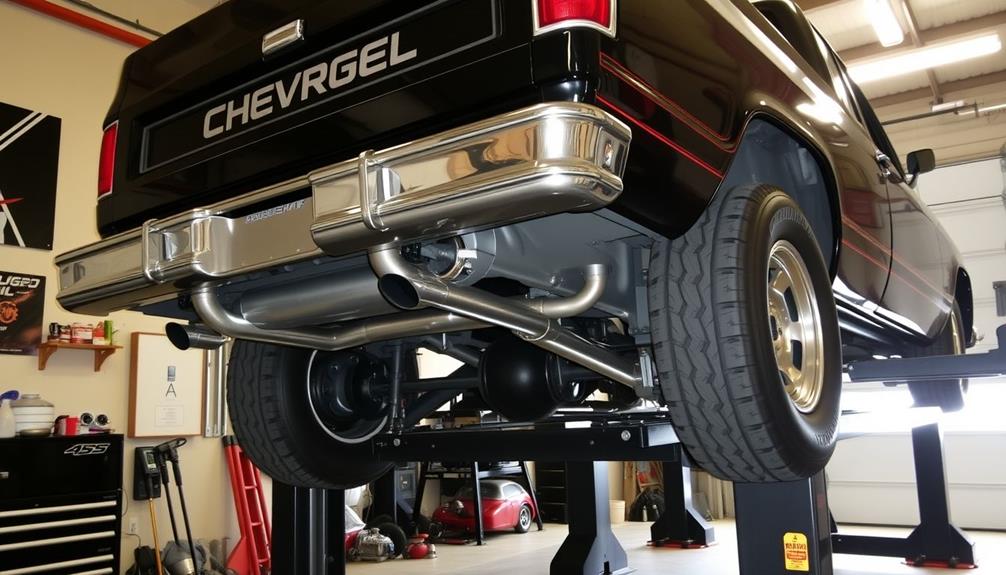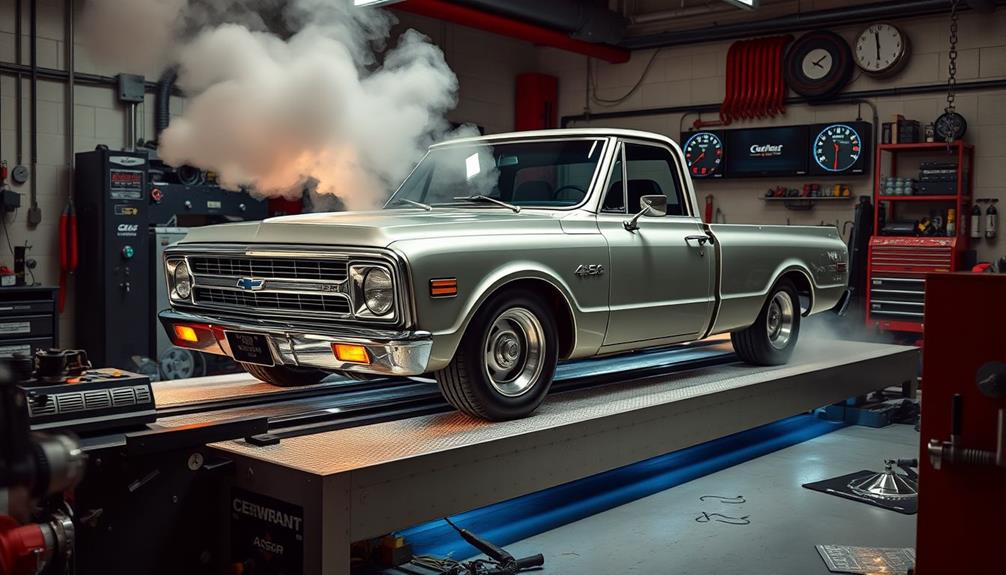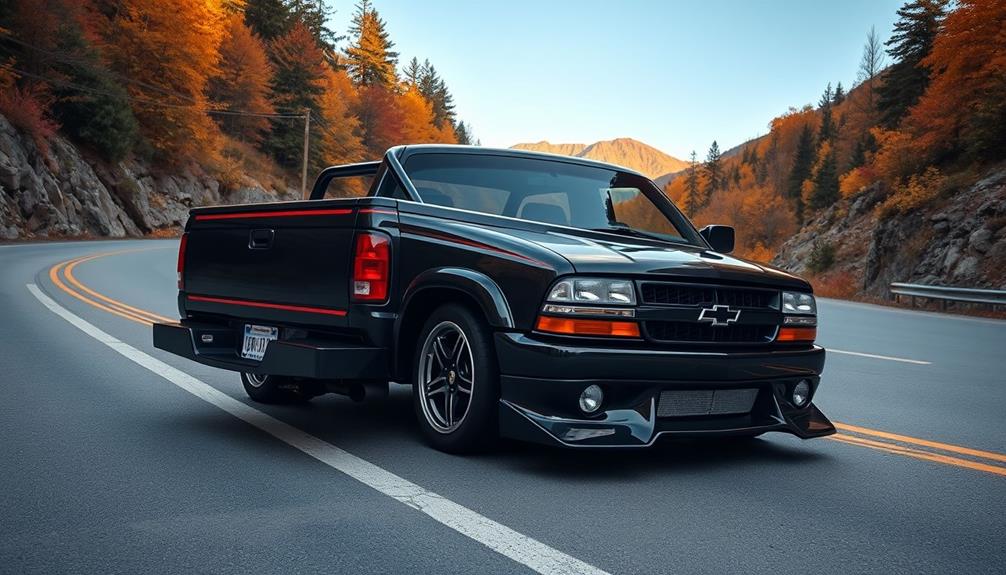To maximize power in your Chevrolet 454 SS, start by tuning your engine with performance upgrades like a high-performance air intake and exhaust system. Upgrading your ignition components, including the ignition coil and spark plugs, can greatly enhance spark efficiency. Don't forget to optimize fuel delivery with a better fuel pump and larger injectors to guarantee adequate flow. Regularly maintain your truck to prevent performance loss. Improving suspension with a drop kit and stiff sway bars will enhance handling, too. Stick around, and you'll discover even more ways to release your classic muscle truck's full potential. If you’re looking for even more ways to unleash the power of your Chevrolet 454 SS, consider exploring ford mustang tuning options. Upgrading your engine management system with a performance tune can optimize fuel and ignition timing for maximum power. Additionally, investing in a set of high-performance tires and brakes will further enhance the performance and overall driving experience of your classic muscle truck.
Key Takeaways
- Upgrade the air intake system to increase airflow, potentially boosting horsepower by 10-15% for improved engine performance.
- Enhance the exhaust system with high-performance components to reduce back pressure and improve throttle response, maximizing power output.
- Install a high-performance ignition system to deliver a stronger spark, improving ignition efficiency and overall engine responsiveness.
- Modify the suspension with stiffer sway bars and performance shocks to enhance handling and stability during acceleration and cornering.
- Regularly maintain and tune the engine, including fuel delivery and spark plug replacement, to ensure optimal performance and reliability.
Historical Context of the 454 SS
The Chevrolet 454 SS emerged in 1990 amid a growing appetite for high-performance vehicles that combined utility with speed. As a standout in the muscle truck market, it introduced a powerful 7.4-liter (454 cubic inch) V8 engine, delivering 230 horsepower and 385 ft-lbs of torque.
With over 13,000 units produced in its debut year, the 454 SS quickly became a notable player, capturing the hearts of truck enthusiasts. This era was competitive, especially with the Ford Lightning aiming to capture the sport truck segment.
The Chevrolet 454 SS was designed for performance, featuring a Turbo 400 3-speed automatic transmission that shifted power seamlessly. Its beefed-up suspension system, complete with a limited-slip rear axle, enhanced handling and traction, making it perfect for both everyday use and spirited driving.
As you consider the historical context, the 454 SS represents a significant chapter in the evolution of American performance vehicles. It showcases how manufacturers took traditional trucks and infused them with high-performance capabilities, appealing to a broader audience of performance seekers while maintaining practicality.
Key Specifications and Features

The 1990 Chevrolet 454 SS boasts a powerful 7.4-liter big block V8 engine that churns out 230 horsepower and 385 ft-lbs of torque, making it a standout in performance.
You'll also appreciate the robust suspension upgrades and limited-slip axle, which enhance handling and stability during spirited drives.
Let's explore how these key specifications contribute to the truck's muscle and maneuverability.
Engine Performance Metrics
Equipped with a formidable 7.4-liter big-block V8 engine, the 1990 Chevrolet 454 SS delivers an impressive 230 horsepower and 385 ft-lbs of torque. This truck combines raw power with a robust Turbo 400 three-speed automatic transmission, ensuring smooth shifts and performance under pressure.
You're looking at a vehicle that weighs about 4,400 pounds, allowing it to balance power with a relatively light chassis for its class. Initial dyno testing revealed that the 454 SS achieved 196.2 horsepower and 290.9 ft-lbs of torque at the wheels, highlighting the potential for further tuning and modifications.
Here's a quick look at the engine performance metrics:
| Metric | Value | Notes |
|---|---|---|
| Engine Displacement | 7.4 liters (454 ci) | Big-block V8 |
| Horsepower | 230 hp | At the crank |
| Torque | 385 ft-lbs | Maximum output |
| Weight | 4,400 lbs | Performance-oriented design |
| Dyno Testing Output | 196.2 hp | At the wheels |
With these specs, the 454 SS stands as a true muscle truck, ready for your tuning adventures!
Suspension and Handling Upgrades
Upgrading the suspension on your 1990 Chevrolet 454 SS can dramatically enhance its handling and overall driving experience. The stock suspension is capable, but with the right upgrades, you can greatly improve performance.
Consider installing a drop kit to lower your truck's center of gravity. This change reduces body roll during cornering, making your ride feel more stable.
Incorporating a limited-slip axle is another effective way to boost traction and power distribution to the rear wheels. This modification enhances acceleration and improves handling, especially during aggressive maneuvers.
Performance shocks and springs are also essential for elevating ride quality and responsiveness. They allow for precise control, ensuring you stay connected to the road.
Don't overlook chassis stiffening modifications, which can improve the overall rigidity of your truck. A stiffer chassis enhances handling characteristics and makes your 454 SS more competitive on the road.
Essential Performance Modifications

When tuning your Chevrolet 454 SS, focusing on essential performance modifications can make a noticeable difference.
Upgrading the engine, enhancing the exhaust system, and improving suspension will boost power, efficiency, and handling.
Let's explore these key areas to release your truck's full potential.
Engine Upgrades Overview
To release the full potential of your Chevrolet 454 SS, focusing on essential performance modifications is key.
Engine upgrades can greatly enhance your truck's capabilities, leading to impressive horsepower increases and overall performance. Here are three important areas to contemplate:
1. Air Intake System: Upgrading the air intake system can improve airflow, often resulting in a horsepower increase of up to 10-15%. This boost is critical for peak power output.
2. Ignition Efficiency: Replacing stock ignition components with high-performance spark plugs, wires, and distributor caps enhances ignition efficiency.
This guarantees reliable starts and maximizes the gains from other modifications.
3. Performance Chip: Installing a performance chip or tuner adjusts your engine's fuel and timing maps.
This upgrade, especially when combined with proper fuel system maintenance, can lead to improved horsepower and torque figures.
Exhaust System Enhancements
The Chevrolet 454 SS's exhaust system plays an essential role in maximizing performance and releasing the engine's true potential. By upgrading to a high-performance exhaust system, you can enhance not only your truck's power output but also its throttle response.
Components like the Flowmaster scavenger Y collector can notably improve exhaust flow efficiency, potentially increasing horsepower by up to 10 in stock V8 setups like yours.
To truly optimize your 454 SS, consider incorporating aftermarket components designed to reduce back pressure, which can further boost performance. Regular inspection and timely replacement of worn exhaust parts are vital, as leaks can lead to power loss and diminished efficiency.
Remember, utilizing quality materials in your exhaust modifications is critical for ensuring longevity and corrosion resistance, especially in classic muscle trucks.
When you focus on these enhancements, you elevate your truck's capabilities while preserving its iconic character.
Don't underestimate the impact of a well-tuned exhaust system—it's one of the most effective ways to unleash the full potential of your Chevrolet 454 SS. Embrace these upgrades, and feel the difference in your driving experience!
Suspension and Handling Improvements
Upgrading your Chevrolet 454 SS's suspension is essential for transforming its handling dynamics. With the right modifications, you can greatly enhance both ride quality and stability, allowing you to enjoy a more controlled driving experience.
Here are three key upgrades to evaluate:
- Drop Kit: Lowering your truck's center of gravity improves stability in corners, making it easier to handle during spirited driving.
- Sway Bars: Installing stiffer sway bars reduces body roll, which helps maintain a level ride during aggressive turns while still preserving comfort.
- Shock Absorbers: Upgrading to high-performance shock absorbers, like gas-charged or adjustable units, increases responsiveness and enhances ride quality, ensuring better handling on any terrain.
Additionally, incorporating a limited-slip differential can improve traction during acceleration, especially beneficial for launching from a standstill.
Pairing these upgrades with performance tires will optimize grip and handling characteristics, allowing your 454 SS to harness its power effectively on the road.
Tuning the Exhaust System

Tuning the exhaust system of your Chevrolet 454 SS can lead to impressive performance gains, often adding up to 10 horsepower. Upgrading to a Flowmaster exhaust system with a scavenger Y collector markedly enhances exhaust flow efficiency.
The scavenger Y collector's D-shaped interface increases contact area, reducing exhaust restriction and improving throttle response. This means a more powerful driving experience that complements your classic muscle truck's engine modifications.
Proper airflow is essential for maximizing performance, so installing a high-quality exhaust system is vital. Not only does it allow for better exhaust flow, but it also works in tandem with other performance upgrades, such as ignition and cooling solutions, to amplify overall power output.
Don't forget the importance of routine maintenance. Regularly inspecting your exhaust system for leaks and ensuring proper connections will help maintain ideal performance.
A well-tuned exhaust system will keep your Chevy 454 SS running at its best, providing you with the power and responsiveness you crave. By focusing on these aspects, you're setting your truck up for success on the road.
Optimizing Fuel Delivery

A well-tuned exhaust system sets the stage for maximizing fuel delivery in your Chevrolet 454 SS.
To truly amplify horsepower and performance, you'll want to pay careful attention to a few key components. Here's what to focus on:
- Upgrade the Fuel Pump: A high-performance fuel pump guarantees adequate fuel flow, especially when you've made modifications. This is essential for maintaining the necessary fuel pressure.
- Install a Performance Fuel Pressure Regulator: This helps maintain ideal fuel pressure, allowing for the right air-fuel mixture. Proper tuning here is critical for maximizing combustion efficiency.
- Larger Fuel Injectors: Installing bigger fuel injectors improves fuel atomization and delivery, which is fundamental for engines pushing over 400 horsepower.
Additionally, don't overlook the importance of a clean fuel filter; regularly checking and replacing it prevents contaminants from disrupting fuel flow.
Finally, tuning your air-fuel ratio using software like TunerPro can greatly enhance combustion efficiency, leading to improved overall performance in your Chevrolet 454 SS.
Ignition System Upgrades

When it comes to boosting the performance of your Chevrolet 454 SS, enhancing the ignition system is a game changer. A strong ignition system guarantees a reliable spark, which is vital for peak combustion and power output. Here's how you can upgrade your setup:
| Upgrade Component | Benefits | Recommended Options |
|---|---|---|
| Performance Ignition Coil | Boosts voltage for a vigorous spark | High-output models |
| High-Performance Spark Plugs | Increases ignition efficiency | Iridium or platinum tips |
| Aftermarket Wires | Minimizes energy loss, stronger spark | Low-resistance options |
Installing high-performance spark plugs with iridium or platinum tips can enhance your engine's efficiency, leading to better fuel economy and increased horsepower. A performance ignition coil will provide that extra voltage, improving throttle response under load. Don't forget to replace stock wires with aftermarket options to guarantee maximum energy delivery to your plugs.
Lastly, regular maintenance of distributor caps and rotors is essential to avoid power loss. Keeping these components in check guarantees your ignition system works efficiently, contributing to a smoother and more powerful driving experience in your Chevy 454 SS.
Routine Maintenance for Performance

Keeping your Chevrolet 454 SS in top shape requires a commitment to routine maintenance that directly impacts performance. By staying on top of these tasks, you can guarantee your classic muscle truck delivers its best power output.
- Replace Spark Plugs: Make sure to replace your spark plugs with OE specifications. This guarantees strong ignition performance, which is essential for maximizing power output and overall efficiency.
- Inspect the Coolant System: Regularly check and flush the coolant system. Preventing overheating is important, especially given the age and mileage of your truck. This helps maintain peak engine performance.
- Check Rear Differential Fluid: Don't overlook the rear differential fluid. Regularly topping it off can considerably enhance driveline efficiency, which is especially important for vehicles like yours with nearly 140,000 miles.
Additionally, replacing the fuel filter is necessary for preventing power loss and guaranteeing a steady fuel supply to the engine.
A thorough driveline inspection, including checking u-joints and transmission housing for leaks, is essential for maintaining reliability and performance in your Chevrolet 454 SS.
Dyno Testing and Results

Regularly conducting dyno testing on your Chevrolet 454 SS can provide invaluable insights into its performance capabilities.
In initial tests, you might find your truck delivering a power output of 196.2 horsepower and 290.9 ft-lbs of torque at the wheels. These figures usually remain consistent across multiple runs.
However, after performing routine maintenance, including spark plug replacements and fuel filter changes, you may see slightly lower results due to transmission losses; a final run might yield 194 horsepower and 300 ft-lbs of torque.
When comparing performance with competitors like the 1994 Ford Lightning, which achieved 224 horsepower and 302 ft-lbs of torque, it's vital to tune both vehicles to stock specifications for a fair performance comparison.
This guarantees you're measuring their capabilities accurately based on factory settings, without aftermarket modifications skewing the results.
Ultimately, dyno testing not only highlights your Chevrolet 454 SS's power output and torque but also emphasizes the impact of regular maintenance on performance.
Keeping your truck in ideal condition is significant for achieving the best possible results during these evaluations.
Future Upgrade Possibilities

Upgrading your Chevrolet 454 SS opens up exciting possibilities for enhanced performance and driving experience.
By focusing on specific components, you can maximize your truck's capabilities and enjoy the thrill of classic muscle with modern power.
Here are three future upgrade possibilities to contemplate:
1. High-Performance Ignition System: Upgrading to high-performance coils and spark plugs can greatly boost your power output and throttle response, making your driving experience more exhilarating.
2. Air Intake System and Performance Exhaust: Installing a high-flow air intake system can improve airflow, potentially increasing horsepower and torque by up to 10% in classic setups.
Pair this with a performance exhaust system like Flowmaster's scavenger Y collectors to reduce backpressure and gain an additional 10 horsepower.
3. Engine Management and Suspension Upgrades: Optimize your engine's air-fuel mixture with advanced engine management software for better fuel efficiency and power.
Additionally, consider suspension upgrades such as lowering kits and improved shock absorbers to enhance handling and stability during acceleration and cornering.
Frequently Asked Questions
How Do I Get More Power Out of My 454?
To get more power out of your 454, upgrade the exhaust system, enhance the ignition system, maintain the fuel system, consider tuning with a custom chip, and lower the stance for improved handling.
How Much Horsepower Can You Get Out of a Chevy 454?
You can release over 400 horsepower from a Chevy 454 with the right modifications. By upgrading the ignition, fuel systems, and adding performance headers, you'll greatly enhance your engine's power and performance potential.
How Much Horsepower Does a 454 SS Truck Have?
The 1990 Chevrolet 454 SS has a factory-rated 230 horsepower and 385 foot-pounds of torque. With modifications, you can boost that power considerably, aiming for over 400 horsepower and enhancing your driving experience.
How Much Horsepower Does a 90S 454 Have?
Imagine a lion, powerful yet restrained. The '90s 454 V8 roars with about 230 horsepower, showcasing its strength. With some tuning, though, you can release that beast, pushing it over 400 horsepower for thrilling rides.
Conclusion
Picture your 454 SS as a classic racehorse, enthusiastic to gallop down the track. By tuning its power and fine-tuning its components, you're not just enhancing performance; you're revealing its true potential. Each modification is like a well-placed horseshoe, giving it the grip to soar. As you maintain this mighty steed, remember: every upgrade is a chance to refine its speed and spirit. With passion and care, you'll turn your truck into a legend on wheels.










